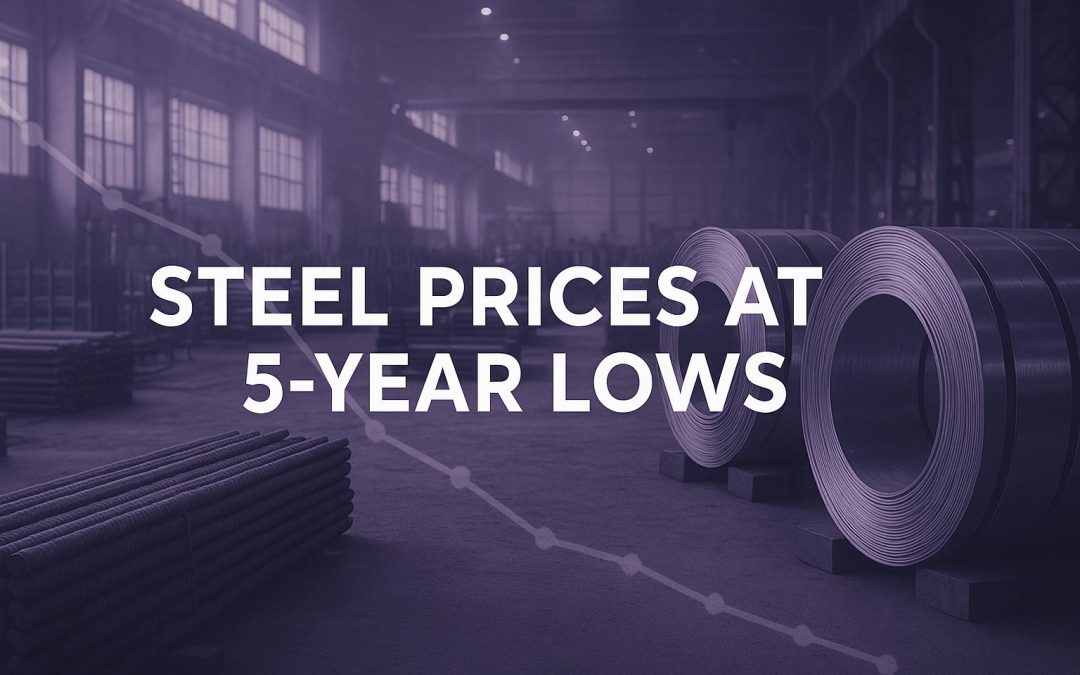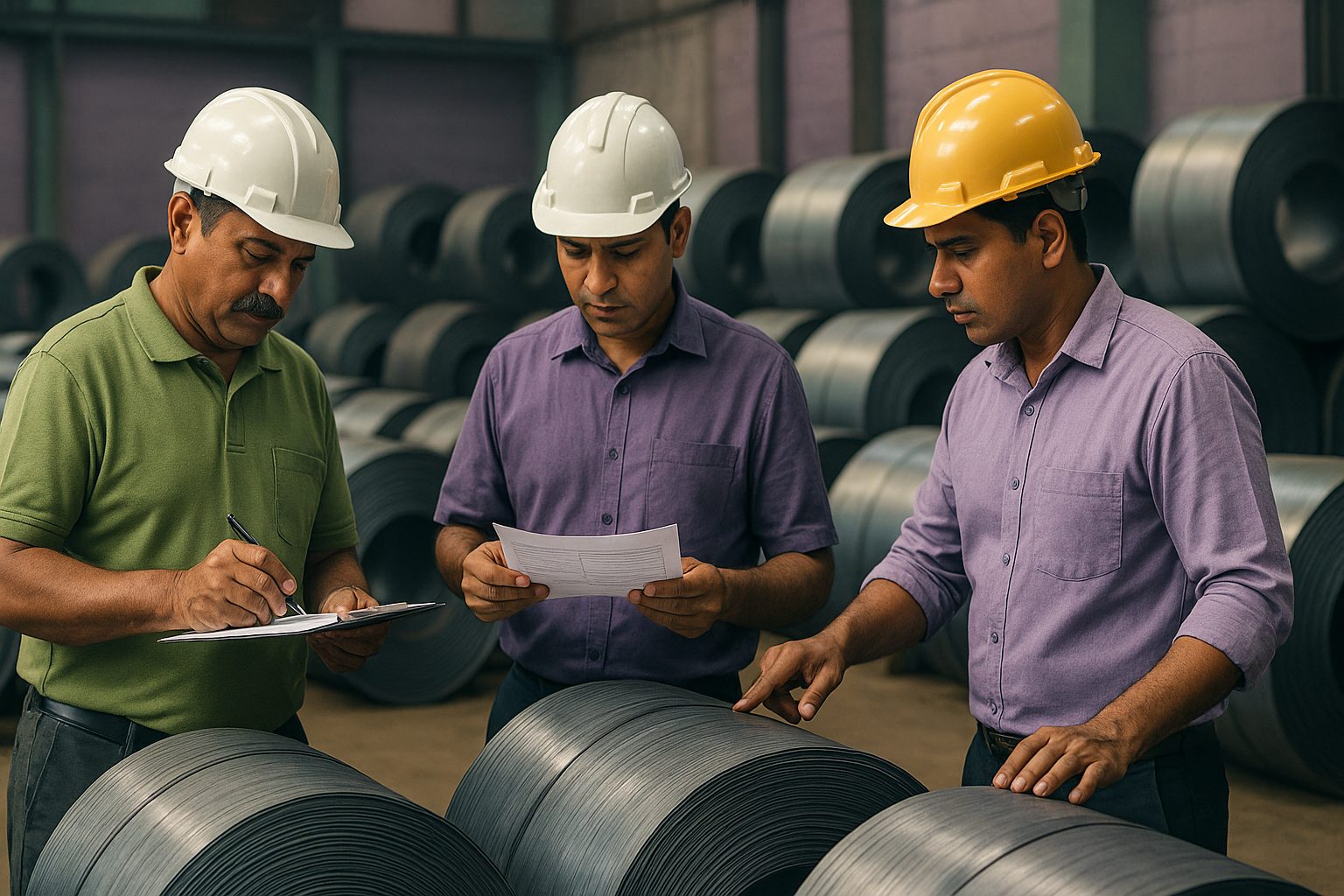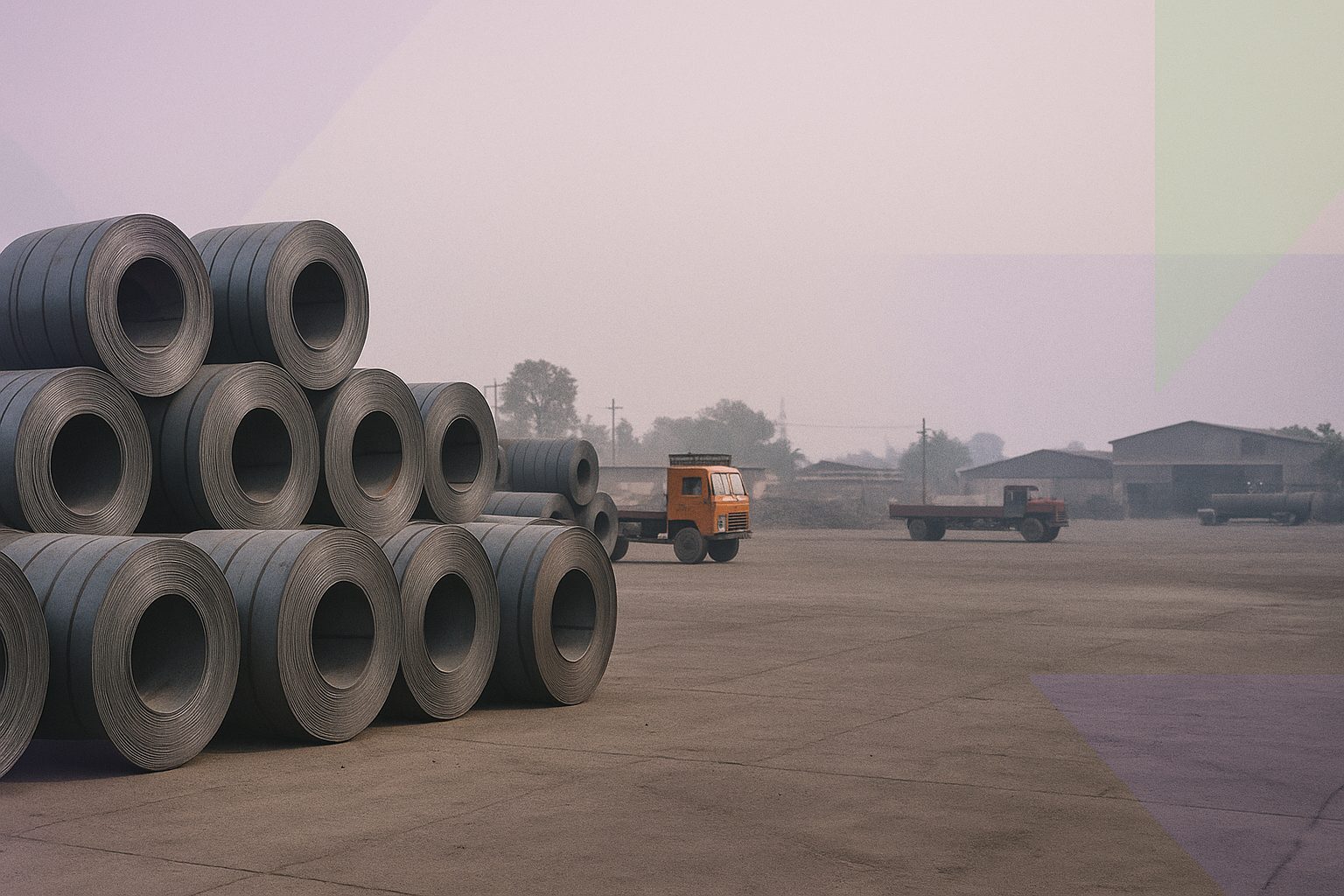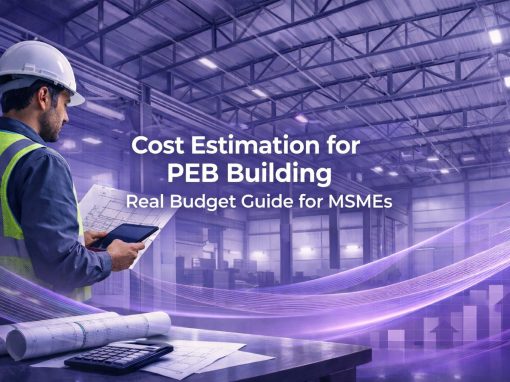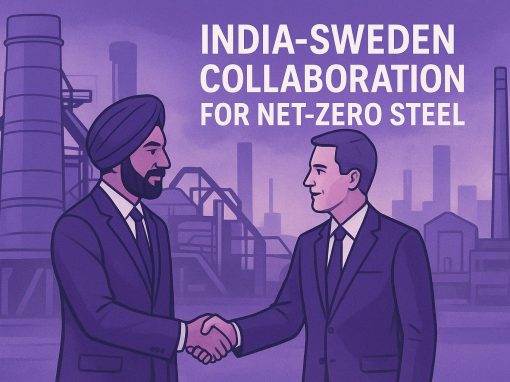Table of Contents
Introduction
Steel prices in India have fallen to their lowest in five years. Though it is quite a rare turn in a sector that’s often influenced by volatility and global cues
In October 2025, hot-rolled coil averaged around ₹47,000 per tonne. On the contrary, rebar hovered around ₹46,500 (Source: The Economic Times).
If evaluated, for large mills, this slide directly refers to tightening margins and cautious production plans. But we when talk for MSMEs, it opens a small yet crucial window – to buy smarter, lock in rates, and rethink how procurement fits into their overall cost strategy. Because in a market this fluid, timing isn’t just an advantage – it’s a competitive edge.
What’s behind the decline
The fall is not random. Cheaper imports from East Asia, sluggish demand from construction and engineering, and excess inventory across mills have all pushed the market down. Analysts expect prices to remain soft through the next quarter. What looks like a cost advantage on paper can easily become a planning risk if delivery schedules or quality checks are ignored.
Why it matters for MSMEs
For small manufacturers, fabricators, and suppliers to public projects, steel is often the single largest raw-material expense. And this sudden drop impacts quotations, tender bids, working-capital cycles, and a lot more. Therefore, the task now is not only to chase low prices, but to buy smart. And as a result, balancing short-term savings with long-term supply stability. The sections ahead break down what caused this decline, how it touches everyday procurement, and what practical steps MSMEs can take before the cycle turns again.
What’s Driving India’s Steel Price Decline
Steel markets work on confidence as much as cost. When that confidence weakens – whether from global cues or local oversupply – prices start to drift lower. And India’s steel sector is witnessing exactly the same in late 2025. For businesses, it becomes essential to separate short-term price movement from long-term structural shifts as it could support them reshape sourcing behaviour in the coming months.
Let’s have a look at some of the main forces that drive the slide in steel prices in India 2025.
Oversupply and inventory build-up
The domestic steel sector is under pressure from a widening supply-demand gap. Latest figures show annual production of finished steel rose sharply in the first half of FY26, while consumption decelerated. The result: wholesalers and mills are carrying higher inventory, forcing them to clear stock at thinner margins. For MSMEs, this means that current “mill gate” rates – part of the broader marker for steel prices in India 2025 – represent a stressed market rather than sustainable pricing.
Sluggish demand from construction and engineering
Any small-and-mid-sized manufacturers rely on the construction and engineering sectors for steady steel consumption. That pipeline has slowed. Reports cite delayed infrastructure approvals, a weaker auto sector, and sluggish private construction as key drags. When downstream demand stalls, mills and traders cut prices to maintain off-take. And creates the softening trend that is visible in today’s price charts.
Competitive imports and weak export markets
Currently, India’s steel trade faces pressure from both ends:
-Cheaper finished steel imports, and,
-Declining exports
In September 2025, only imports touched nearly 0.8 million tonnes. Thus, marking the sixth straight month of net import growth. However, with limited export relief and high inbound supply, domestic mills have little choice but to reduce prices.
| Metric (Sep 2025) | Value | Why it matters |
| Finished Steel Imports | 0.65 Mt (net importer) | Sustains downward price pressure |
| Domestic Production | 13.3 Mt | Inventories rising at mill-level |
| Domestic Consumption | 13.5 Mt | Consumption slower than expected |
| Export Orders | Weak | Limits price support from overseas demand |
Raw-material costs aren’t falling equally
While finished steel rates are sliding, input costs such as iron ore and coking coal have not eased proportionately. Even, some are firming due to tighter mining supply. For businesses, this mismatch matters. Essentially, it means producers’ margins are under strain, and therefore, raising risks of quality shortcuts or delayed deliveries.
How Falling Prices affect MSME Procurement
When steel prices slide, the first reaction may be relief – lower input cost, improved margin. But for MSMEs, the real impact is more complex. The current drop in steel prices in India 2025 changes the steel procurement dynamics in several ways: contract terms need adjustment, working-capital shifts, and supplier behaviour alters.
Longer lead times and delivery risk
Lower steel prices often reflect oversupply or mills reducing output to protect margins. In this environment, suppliers may delay dispatch or prioritise larger buyers. An MSME fabricator targeting bids for a construction job may find that a quoted rate aligned with the rate table moves quickly – or delivery gets pushed. That delivers cost savings on paper, but project execution suffers. In steel procurement for MSMEs the bottleneck often becomes delivery, not price.
Bidding and tender costs under pressure
When the market signals “steel at hit five year lows”, many vendors rush to quote aggressively. For an MSME bidding on a government tender, this can backfire. If steel price recovery hits mid-execution, the bidder bears the extra cost. Quoting based purely on a “low price now” without escalation safeguards becomes risky. With steel market outlook 2025 unsettled, clauses for price variation or supply credit terms are no longer optional.
Working-capital and buffer stock adjustments
A cheaper tonne of steel means less cash outflow upfront – but it may also signal caution: inventory ages, stockholding turns costly, and upcoming orders could change. Many MSMEs wait to purchase once price falls further, but this waiting game can disrupt production. For example, a small component maker delaying bulk purchase US-style may struggle when grade availability shifts or freight cost spikes. Managing landed cost calculation – in which mill gate price is just one input – is essential.
Supplier negotiation leverage
Falling rates do give MSMEs stronger negotiating power. If your vendor sees margin stress, you can ask for longer payment terms, flexible delivery schedules, quality certs or locked-in rates. A local steel distributor under pressure to clear inventory may accept a 60-day credit instead of 30-day, or agree to a fixed price for a three-month contract. That forms part of an MSME procurement strategy aligned with raw-material cost India conditions.
An instance on workflow adjustment
Imagine a small fabrication firm that typically places monthly orders for steel rebar and hot-rolled coil. With the steel price chart 2025 pointing downwards, they decide to shift to a quarterly contract with their supplier. The contract locks in the current low rate and includes delivery in two batches. The first batch is held as buffer stock for immediate jobs; the second arrives just-in-time when new tenders begin. By doing so, the firm alleviates frequent reorder logistics, spreads freight cost and improves cash-flow control.
In summary, while the drop in steel prices in India presents real opportunity, it also shifts procurement focus: away from “just the rate” to “terms, timing, reliability”. For businesses, turning the momentary benefit into lasting advantage means adjusting operations now.
Also read: Tata Steel procurement process: Know the strategy
Procurement Strategy in a Low-Price Cycle
When prices are low, most of the buyers think about bulk purchase. But experienced procurement professionals know the real strategy lies in balance. They exactly know how much to buy, when to lock in, under what terms, and so on. For businesses, this phase of steel prices in India is not just a buying window; it’s a test of discipline. The market will not stay at five-year lows forever, and decisions made now will shape business cash flow, supplier relations, and production stability for months ahead.
Here are a few procurement approaches that can help businesses make the most of this low-price cycle while staying financially steady.
Timing and quantity planning
In real procurement cycles, timing matters more than the exact price point. A one-month delay in delivery or a one-grade mismatch can erase the advantage of a cheaper quote. The best approach is to stagger purchases – part immediate, part conditional.
Diversifying supplier base
In a falling-price market, over-dependence only on one vendor becomes risky. Secondary steel manufacturers and local distributors often struggle with thin margins and liquidity when prices drop. For MSMEs, the answer lies in supplier diversification.
Engage two to three vendors across different regions to spread delivery and quality risk. Regional diversity cushions freight spikes and ensures supply continuity if one partner delays dispatch. This is particularly useful for firms supplying to government or EPC projects where non-delivery penalties can offset any savings from low steel rates.
Strengthening contract terms and quality clauses
Price fluctuations demand stronger paperwork. Every contract during a low-price cycle should clearly define delivery windows, payment terms, grade specifications, and variation clauses. Many MSMEs skip these details in the interest of quick procurement. That’s a costly mistake.
If a supplier later pleads “price revision” or delays due to inventory shortage, these clauses serve as the buyer’s safety net. Standardising such contracts now will also help MSMEs prepare for tenders and audits under the Make in India and Domestic Procurement Policy.
Focus on landed cost – not just mill rate
The mill gate price might look attractive at ₹47,000 a tonne, but by the time freight, local taxes, unloading, and handling are added, the actual landed cost could rise by 6–10 percent. MSME procurement teams must calculate the real cost per tonne delivered to their facility, not just the invoice amount.
A practical step is to build a simple landed cost calculator:
- Base mill rate
- Freight and handling
- GST and local levies
- Loading/unloading charges
- Inventory carrying cost
Tracking these consistently ensures every procurement decision is based on delivered cost, not speculative price boards.
Negotiating smartly during the downturn
Low markets offer leverage – if used wisely. Instead of simply asking for discounts, MSMEs can negotiate extended payment windows, quality assurance reports, or bundled freight. Suppliers often prefer flexibility over further price cuts.
For example, a small auto-component manufacturer in Pune renegotiated its vendor terms to include 90-day credit and door-delivery instead of ex-warehouse pickup. The price remained the same, but savings came from reduced transport and improved cash rotation.
Building a procurement playbook for the next cycle
This low-price period is the right time to document learnings – rate trends, supplier responsiveness, freight data, and contract behaviour. Keeping a simple internal “steel procurement log” helps MSMEs refine decisions for future cycles. When prices rebound, such documentation enables faster response: deciding whether to hedge, pre-book or defer purchases.
Therefore, it can be said that every low-price cycle feels like an opportunity, yet only those who plan procurement with structure truly benefit. For MSMEs, that means securing dependable suppliers, locking in balanced contracts, and measuring cost beyond the mill gate. The coming quarter is not only about saving on steel – it’s about strengthening systems before the market hardens again.
Hidden Costs still Impacting your Landed Price
When steel prices in India hit multi-year lows, most procurement discussions stop at the mill gate. But for MSMEs, that’s where the real cost journey begins. The mill rate is only a starting point – by the time the raw material reaches a fabrication shed or plant, several hidden charges inflate the total expense. And it is very common among MSMEs to overlook these variables.
Thus, they assume that lower market prices automatically mean lower overall cost. In practice, that’s rarely true. Below are the most common cost layers that silently erode savings.
Freight and handling charges
Freight is often the largest invisible cost component. Even within the same state, rates can vary 8–10 percent depending on route, truck availability, and load size. For MSMEs that buy in partial truckloads (PTL), this difference widens further. A shipment from Bhilai to Indore, for example, could cost ₹1,200–₹1,500 per tonne in freight – enough to neutralise a small dip in steel prices in India.
Handling and unloading charges also add up, particularly for unmechanised yards or when cranes are hired temporarily. Tracking these consistently is essential to prevent “invisible inflation” in procurement budgets.
Landed cost calculation (Bhilai → Indore)
| Cost Component | Approx. ₹/tonne |
|---|---|
| Mill Gate Price | 47,000 |
| Freight + Route Handling | 1,350 |
| GST + Local Levies | 2,100 |
| Loading/Unloading | 250 |
| Inventory Carrying (short-term) | 600 |
| Estimated Landed Cost | 51,300 |
This quick snapshot of landed cost shows how a ₹47,000 quotation can easily convert into a ₹51,000 plus. This is the number businesses must compare and not wholesale screens.
Local taxes, duties, and octroi equivalents
Even though GST has unified much of India’s indirect tax structure, certain state-specific cess or local levies still apply on commercial vehicle entry and transit. When multiple states are crossed – say, a supplier in Maharashtra dispatching to Rajasthan – minor charges like entry fee, border handling, and form compliance often add ₹300–₹400 per tonne. For a small manufacturer operating on thin margins, these charges can quietly raise landed cost by 3–4 percent.
Inventory holding and carrying costs
When prices fall, buyers tend to stock up. But storage isn’t free. Rent, handling, security, insurance, and working-capital blockage together form the inventory shipping cost. For most MSMEs, this ranges from 10–14 percent annually. In a low-price cycle, overstocking can trap liquidity just when better deals appear later. Therefore, a smarter move here is to align storage volume with confirmed orders or short-term visibility rather than speculative buying.
Quality deviations and rejection losses
Cheaper supply periods often lead to looser quality control among distributors under margin pressure. If steel grades deviate or surface defects appear, replacement cycles can add cost far beyond any saving. MSMEs must insist on mill test certificates (MTC) and check grade traceability before unloading. A rejected batch not only affects cost but also delays project execution – a risk often ignored when the focus is solely on price.
Payment terms and credit costs
Suppliers facing cash strain may offer shorter credit windows or upfront payment requirements. If an MSME bridges that gap through short-term borrowing, the interest effectively adds another hidden cost. Negotiating credit terms aligned with project payment cycles helps balance liquidity and avoid unnecessary finance expense.
So for a instance, if the steel rate at the mill may be ₹47,000 per tonne, but the real landed cost could easily exceed ₹52,000 once logistics, taxes, and financing are considered. For MSMEs, mastering these details is as important as tracking the market trend. A low market price only creates opportunity; understanding total cost ensures that opportunity turns into real savings.
Policy, forecast and what’s next
The policy environment now plays as much of a role in shaping steel prices in India as global trade or mill production. For MSMEs, staying aware of these policy movements is no longer optional – it directly affects sourcing options, supplier pricing, and tender competitiveness.
Domestic procurement and PLI incentives
The government continues to push domestic value addition through the PLI scheme for speciality steel and the Domestically Manufactured Iron & Steel Products (DMI&SP) policy. Both aim to strengthen local manufacturing and curb dependency on imports. For MSMEs supplying to large EPCs or public projects, this means better visibility of certified Indian suppliers – but also tighter documentation requirements. Having BIS-certified mill sources and ensuring value-add compliance under these schemes can give smaller vendors a competitive edge in upcoming tenders.
At the same time, local mills are under pressure to justify incentives through production commitments. This can create short-term supply imbalances when demand suddenly revives. Procurement heads should therefore build vendor lists that include both integrated and secondary producers to avoid disruption.
Global and domestic price outlook
Analysts expect steel prices inIndia to stay soft through Q1 FY26, with only a gradual recovery from mid-2026, depending on infrastructure project restarts and global demand from China and Europe. (Source: Economic Times)
For MSMEs, this provides a limited window to re-negotiate supply contracts and stabilise costs for the next two quarters. However, once demand re-establishes, price volatility will likely return. And, especially this will happen when export markets open up and domestic inventories clear faster than expected.
Conclusion
Steel’s five-year low is more than a market headline! And is a moment of reckoning for MSME procurement. When raw material costs drop, businesses gain breathing room, but only those that act deliberately will turn this window into real advantage. The key lies in control – of timing, supplier diversity, documentation, and landed cost.
Low prices come and go. What stays is the discipline to negotiate fair terms, maintain quality vigilance, and forecast with data rather than instinct. MSMEs that use this phase to formalise vendor contracts, track freight patterns, and adopt structured cost monitoring will be better prepared when the cycle hardens again.
The next quarter offers stability, not certainty. Those who buy smart – locking in rates without locking out flexibility – will preserve margins even when prices rebound. In procurement, every decision taken in a calm market decides how resilient a business becomes in a volatile one. For MSME buyers, this is the time to treat steel not just as a commodity, but as a strategy.
Looking to procure steel?
Tata nexarc helps manufacturers, builders and MSMEs source certified steel products, compare prices, and choose the right grade as per IS codes—with complete traceability and procurement confidence.
FAQs
How do falling steel prices in 2025 impact MSME project costing and tender bids?
What are the ideal contract lengths for MSMEs during a steel price slump?
How can small manufacturers negotiate fair delivery terms without bulk-buying capacity?
What risks do MSMEs face when importing finished steel from neighbouring countries?
What are the early signals that steel prices may rebound in FY26?
How do price drops affect supplier credit, insurance, and working-capital cycles for small firms?
Can MSMEs use e-procurement platforms or demand aggregation tools for better steel pricing?
How can logistics optimisation lower overall steel procurement cost for regional MSMEs?
Are there specific grades or product categories most affected by current price corrections?
Charul is a content marketing professional and seasoned content writer who loves writing on various topics with 3 years of experience. At Tata nexarc, it has been 2 years since she is helping business to understand jargon better and deeper to make strategical decisions. While not writing, she loves listing pop music.
